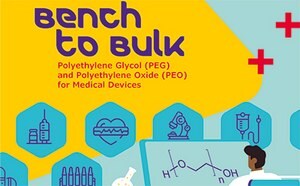Contact Lens & Dental Manufacturing
Contact lens and dental manufacturing are rapidly evolving disciplines using material and manufacturing innovations to improve ophthalmic and oral health. Partner with us to source quality raw materials and obtain supply chain security from scale-up through production with flexible bulk and customization options.
Contact Lens Manufacturing
Contact lenses are ophthalmic prosthetic devices used for vision correction, therapeutics, and cosmetic applications. Contact lens are typically produced from polymer- or silicone-hydrogel materials due to their enhanced oxygen and water permeability. Material selection also influences surface smoothness, UV radiation absorption, and resistance to tearing and surface defects. Precision manufacturing technologies have enabled further tailoring of contact lens properties, including molding processes, lathe cutting, and plasma processing. To alleviate adverse effects from infection and inflammation and improve consumer comfort and safety, research is currently focused on developing new monomers, polymer chemistries, and manufacturing methods.
Dental Manufacturing
Dental medicine aims to manage oral health, combat and treat oral disease, and correct teeth and jaw misalignment. Dental manufacturing utilizes diverse solid-state and polymeric syntheses, processing, and surface functionalization methods to fabricate materials, products, and equipment used in dentistry. Fillings, caps, crowns, and bridges are made from resin-based composites; glass ionomers and alloys are used for restorative dentistry applications. Dental impressions use alginate materials to form accurate negative molds for 3D models of teeth and soft tissues. Aesthetic dental care applications include teeth bleaching with peroxide compounds and porcelain veneer bonding to teeth with light-cured resin cements.
Research in dental materials is focused on next-generation monomers to enhance flexibility, durability, biocompatibility, and antimicrobial properties. Utilizing computer-aided design (CAD) and computer-aided manufacturing (CAM), custom-fitted dentures, dental implants, and orthodontic devices, can now be made quickly and inexpensively using 3D printing.
Related Technical Articles
- The manufacture of monomers for use in ophthalmic applications is driven by the need for higher purity, improved reliability of manufacturing supply, but ultimately by the need for the increased comfort, convenience, and safety of contact lens wearers. Daily wear contact lenses have the potential to fill this need for many customers; however, their widespread use is constrained by higher costs compared to weekly- or monthly-based lenses. New approaches that improve cost structure and result in higher quality raw materials are needed to help make contact lenses more affordable and accelerate growth of the contact lens market.
- We offer a continuously expanding selection of high-purity monomers and polymers for ophthalmic applications, along with a full range of initiators, crosslinkers, dyes, and solvents.
- Innovation in dental restorative materials is driven by the need for biocompatible and natural-appearing restoration alternatives. Conventional dental materials like amalgam and composite resins have inherent disadvantages.
- With dentists placing nearly 100 million dental fillings into patients′ teeth annually in the U.S. alone, polymeric composite restoratives account for a very large share of the biomaterials market.
- Atom transfer radical polymerization (ATRP) has emerged as one of the most successful synthetic techniques for the preparation of polymers with predetermined molecular weights, narrow molecular weight distributions, and high degrees of chain end functionalities.
- See all (8)
Related Protocols
- We present an article about RAFT, or Reversible Addition/Fragmentation Chain Transfer, which is a form of living radical polymerization.
- RAFT (Reversible Addition-Fragmentation chain Transfer) is a form of living radical polymerization involving conventional free radical polymerization of a substituted monomer in the presence of a suitable chain transfer (RAFT) reagent.
- An article about the typical procedures for polymerizing via ATRP, which demonstrates that in the following two procedures describe two ATRP polymerization reactions as performed by Prof. Dave Hadddleton′s research group at the University of Warwick.
- See all (3)
Pour continuer à lire, veuillez vous connecter à votre compte ou en créer un.
Vous n'avez pas de compte ?

